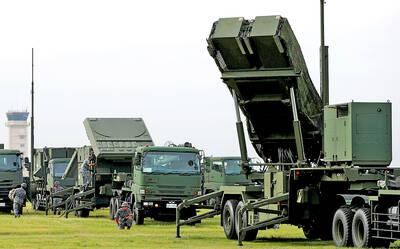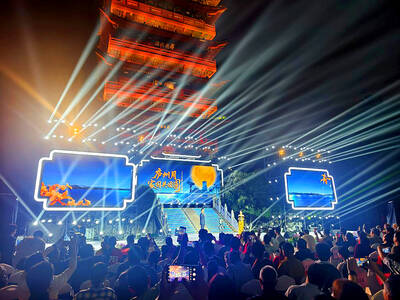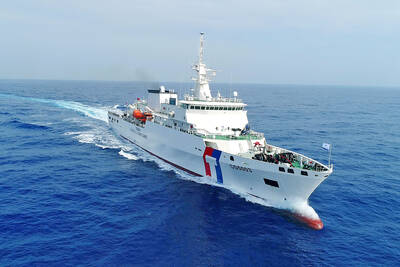The government’s plan to sign an economic cooperation framework agreement (ECFA) with China will further improve cross-strait relations and put pressure on China to remove the missiles it aims at Taiwan, President Ma Ying-jeou (馬英九) said.
“We believe China will face mounting pressure from both Taiwan and the international community to handle the missiles, because no one will understand why China has missiles targeting Taiwan if it is doing business with us,” he said.
The Ma administration is expected to sign an ECFA with China next month. The Democratic Progressive Party (DPP) has accused the government of selling out Taiwan in the face of widespread public concern about the impact of the economic pact on local businesses and workers.
Ma yesterday dismissed concerns that an ECFA would bring about Taiwan’s economic dependence on China, saying that his administration would always insist on Taiwan’s sovereignty.
“Taiwan and China are co-dependent in economic terms ... The government does not support de jure independence, but we will not talk about unification with China, either,” he said.
In response to an upcoming rally organized by the DPP to protest against the ECFA, Ma accused the DPP of making groundless accusations against his administration by saying that the trade deal is the first step toward ultimate unification.
“The government will try to lower the impact of the ECFA on local industries, but it is unreasonable for the opposition camp to claim that the pact is the first step toward unification,” Ma said.
In a mid-term assessment of his presidency, Ma went on to say that the improvement in cross-strait relations has had a positive impact on Taiwan’s relationship with the US, adding that the government is currently negotiating with the US on a new arms sale package to strengthen national defense.
The previous two US arms sale packages were planned 10 years ago. The Ministry of National Defense is now discussing a new list of weapons it wishes to procure from the US, he said.
“Taiwan will not engage in a competition of military force with China. We will seek arms procurement with the US to obtain self-defense weapons such as F-16C/D fighter jets, and enhance cooperation on national security,” the president said.
Taiwan has been requesting 66 fighters, an upgrade on its current stock of F-16A/Bs, since 2006, to replace its aging fleet of F-5s and French-made Mirage 2000-5s, which will become obsolete before 2025.
The F-16C/Ds, however, were not included as part of the US$6.4 billion (NT$201 billion) US arms sale package, including missiles, helicopters and ships, announced by US President Barack Obama in January.
China has expressed strong opposition to the inclusion of the fighters in future arms sales, which the US is required to provide under the Taiwan Relations Act.
Ma said the US understood Taiwan’s needs and it was assessing the procurement list including the F-16C/Ds, adding that the US arms purchases will enhance Taiwan’s national defense and boost national confidence when negotiating with China.

MILITARY BOOST: The procurement was planned after Washington recommended that Taiwan increase its stock of air defense missiles, a defense official said yesterday Taiwan is planning to order an additional four PAC-3 MSE systems and up to 500 missiles in response to an increasing number of missile sites on China’s east coast, a defense official said yesterday. The official, who spoke on condition of anonymity, said that the proposed order would be placed using the defense procurement special budget, adding that about NT$1 trillion (US$32,88 billion) has been allocated for the budget. The proposed acquisition would include launchers, missiles, and a lower tier air and missile defense radar system, they said The procurement was planned after the US military recommended that Taiwan increase

POLITICAL AGENDA: Beijing’s cross-strait Mid-Autumn Festival events are part of a ‘cultural united front’ aimed at promoting unification with Taiwan, academics said Local authorities in China have been inviting Taiwanese to participate in cross-strait Mid-Autumn Festival celebrations centered around ideals of “family and nation,” a move Taiwanese academics said politicizes the holiday to promote the idea of “one family” across the Taiwan Strait. Sources said that China’s Fujian Provincial Government is organizing about 20 cross-strait-themed events in cities including Quanzhou, Nanping, Sanming and Zhangzhou. In Zhangzhou, a festival scheduled for Wednesday is to showcase Minnan-language songs and budaixi (布袋戲) glove puppetry to highlight cultural similarities between Taiwan and the region. Elsewhere, Jiangsu Province is hosting more than 10 similar celebrations in Taizhou, Changzhou, Suzhou,

TWO HEAVYWEIGHTS: Trump and Xi respect each other, are in a unique position to do something great, and they want to do that together, the US envoy to China said The administration of US President Donald Trump has told Chinese President Xi Jinping (習近平) “we don’t want any coercion, but we want [the Taiwan dispute] resolved peacefully,” US ambassador to China David Perdue said in a TV interview on Thursday. Trump “has said very clearly, we are not changing the ‘one China’ policy, we are going to adhere to the Taiwan Relations Act, the three communiques and the ‘six assurances’ that were done under [former US president Ronald] Reagan,” Perdue told Joe Kernen, cohost of CNBC’s Squawk Box. The act, the Three Joint Communiques and the “six assurances” are guidelines for Washington

DEEPENING TIES: The two are boosting cooperation in response to China’s coercive actions and have signed MOUs on search-and-rescue and anti-smuggling efforts Taiwan and Japan are moving to normalize joint coast guard training and considering the inclusion of other allies, the Japanese Yomiuri Shimbun reported yesterday. Both nations’ coast guards in June sent vessels to the seas south of the Sakishima Islands to conduct joint training, the report said, adding that it was the second joint maritime training exercise since the nations severed formal diplomatic ties in September 1972. Japan dispatched the Nagoya Coast Guard’s Mizuho, a 134m, 6,000-tonne patrol vessel which can carry a helicopter, while the Coast Guard Administration (CGA) sent the 126m, 4,000-tonne Yunlin, one of its largest vessels, the report